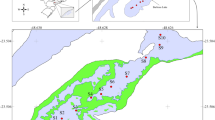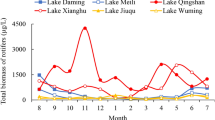Abstract
Seasonal changes of the plankton rotifer community in an eutrophic Czech reservoir were evaluated in relation to 46 environmental variables. To do this, data of rotifer abundance from three growing seasons (1993 – 1995) were analyzed. The seasonal dynamics of rotifers in all three years were characterized by two distinctive aspects: (1) the spring peak, with both maximum density and maximum species diversity, was dominated by Keratella cochlearis, K. hiemalis, K. quadrata and Polyarthra dolichoptera; (2) the summer-autumnal peak (or several lower peaks) of about half the intensity of the spring one, was composed mainly of Keratella cochlearis, Trichocerca similis and Polyarthra vulgaris. The separation between these two peaks coincided with the decline of phytoplankton and development of a clear-water phase in this reservoir. In redundancy analysis, species-abundance data for rotifers were related to all measured environmental variables. Date, abundance of Cyclops vicinus, total nitrogen, primary production, surface temperature, and density of heterotrophic nanoflagellates were identified as the most important variables. Partial redundancy analysis was used to assess the significance of pure and date-structured environmental factors influencing rotifers during the season. Date-structured environmental factors (such as physical and chemical variables, food, competition, and predation) significantly affected the rotifer community. This study shows that the rotifers in the reservoir are controlled by both abiotic and biotic factors.
Similar content being viewed by others
References
Bersier, L. F. & D. R. Meyer, 1994. Bird assemblages in mosaic forests: the relative importance of vegetation structure and floristic composition along the successional gradient. Acta Oecologica 15: 561–576.
Bérziņš, B. & B. Pejler, 1987. Rotifer occurrence in relation to pH. Hydrobiologia 147: 107–116.
Bérziņš, B. & B. Pejler, 1989a. Rotifer occurrence in relation to temperature. Hydrobiologia 175: 223–231.
Bérziņš, B. & B. Pejler, 1989b. Rotifer occurrence in relation to trophic degree. Hydrobiologia 182: 171–180.
Borcard, D., P. Legendre & P. Drapeau, 1992. Partialling out the spatial component of ecological variation. Ecology 72: 1045- 1055.
Brandl, Z. & C. H. Fernando, 1981. The impact by cyclopoid copepods on zooplankton. Verh. Int. Ver. Limnol. 21: 1573–1577.
Brandl, Z., B. Desortová, J. Hrbáčcek., J. Komárková, V. Vyhnálek, J. Sed'a & M. Straškraba, 1989. Seasonal changes of zooplankton and phytoplankton and their mutual relations in some Czechoslovak reservoirs. Arch. Hydrobiol. Beih. Ergebn. Limnol. 33: 597–604.
Hessen, D. O., B. A. Faafeng & T. Andersen, 1995. Replacement of herbivore zooplankton species along gradients of ecosystem productivity and fish predation pressure. Can. J. Fish. aquat. Sci. 52: 733–742.
Hunter, M. D. & P. W. Price, 1992. Playing chutes and ladders: heterogeneity and the relative roles of bottom-up and top-down forces in natural communities. Ecology 73: 724–732.
Komárková, J., 1993. Cycles of phytoplankton during long-term monitoring of Rímov and Slapy reservoir (Czech Republic). Verh. Int. Ver. Limnol. 25: 1187–1191.
Kopáčcek, J. & J. Hejzlar, 1993. Semi-micro determination of total phosphorus in fresh waters with perchloric acid digestion. Int. J. environ. anal. Chem. 53: 173–183.
Kopáčcek, J. & L. Procházková, 1993. Semi-micro determination of ammonia in water by the rubazoic acid method. Int. J. environ. anal. Chem. 53: 243–248.
Koste, W., 1978. Rotatoria. Die Rädertiere Mitteleuropas. Begründet von Max Voigt, Vol. I, II. Borntraeger, Berlin, 673 pp., 234 pl.
Kulikov, A. S., A. O. Shkute & L. V. Polishchuk, 1992. Feeding in juvenile Leptodora kindtii (Focke). Sov. J. Eco. 22: 202–205.
Lehman, J. T., 1991. Interacting growth and loss rates: the balance of top-down and bottom-up controls in plankton communities. Limnol. Oceanogr. 36: 1546–1554.
Lepš, J. S., M. Straškraba, B. Desortová & L. Procházková, 1990. Annual cycles of plankton species composition and physical chemical conditions in Slapy Reservoir detected by multivariate statistics. Arch. Hydrobiol. Beih. Ergebn. Limnol. 33: 933–945.
MacIsaac, H. J. & J. J. Gilbert, 1991. Discrimination between exploitative and interference competition between Cladocera and Keratella cochlearis. Ecology 73: 927–937.
Matčena, J., 1995. The role of ecotones as feeding grounds for fish fry in a Bohemian water supply reservoir. Hydrobiologia 303: 31–38.
McQueen, D. J., J. R. Post & E. L. Mills, 1986. Trophic relationships in freshwater pelagic ecosystems. Can. J. Fish. aquat. Sci. 43: 1571–1581.
Murphy, I & J. P. Riley, 1962. A modified single-solution method for the determination of phosphate in natural waters. Anal. Chim. Acta 27: 31–36.
Pinel-Alloul, B., T. Niyonsenga & P. Legendre, 1995. Spatial and environmental components of freshwater zooplankton structure. Ecoscience 2: 1–19.
Pourriot, R., 1977. Food and feeding habits of Rotifera. Arch. Hydrobiol. Beih. Ergebn. Limnol. 8: 243–260.
Procházková, L., 1959. Bestimmung der Nitrate imWasser. Z. Anal. Chem. 167: 254–260.
Procházková, L., 1960. Einfluss der Nitrate und Nitrite auf die Bestimmung des organischen Stickstoffs und Ammonimus im Wasser. Arch. Hydrobiol. 56: 179–185.
Procházková, L., 1961. Ñber die Anwendung des Chloranilsäureverfahrens zur kolorimetrischen Sulfatbestimmung imWasser. Z. Anal. Chem. 183: 103–107.
Reynolds, C. S., 1984. The Ecology of Freshwater Phytoplankton. Cambridge Studies in Ecology. Cambridge University Press, Cambridge.
Sanders, R. W., D. A. Leeper, C. H. King & K. G. Porter, 1994. Grazing by rotifers and crustacean zooplankton on nanoplanctonic protists. Hydrobiologia 288: 167–181.
Sed'a, J. & J. Kubečcka, 1997. Long-term biomanipulation of č Rímov reservoir (Czech Republic). Hydrobiologia 345: 95–108.
Stemberger, R. S., 1995. The influence of mixing on rotifer assemblages of Michigan lakes. Hydrobiologia 297: 149–161.
Stemberger, R. S. & M. S. Evans, 1984. Rotifer seasonal succession and copepod predation in LakeMichigan. J. Great Lakes Res. 10: 417–428.
Stemberger, R. S. & J. M. Lazorchak, 1994. Zooplankton assemblage responses to disturbance gradients. Can. J. Fish. aquat. Sci. 51: 2435–2447.
Straškrabová, V., J. Komárková & V. Vyhnálek, 1993. Degradation of organic substances in reservoirs. Wat. Sci. Tech. 28: 95–104.
Šimek, K., M. Macek, J. Pernthaler, V. Straškrabová & R. Psenner, 1996. Can freshwater planktonic ciliates survive on a diet of picoplankton? J. Plankton Res. 18: 597–613.
ter Braak, C. J. F. 1994. Canonical community ordination. Part 1: Basic theory and linear methods. Ecoscience 1: 127–140.
ter Braak, C. J. F. & I. C. Prentice, 1988. A theory of gradient analysis. Adv. Ecol. Res. 18: 271–317.
ter Braak, C. J. F. & P. F. M. Verdonschot, 1995. Canonical correspondence analysis and related multivariate methods in aquatics ecology. Aquat. Sci. 57: 255–289.
Walz, N., 1995. Rotifer populations in plankton communities: Energetics and life history strategies. Experientia 51: 437–453.
Wickham, S. A. & J. J. Gilbert, 1991. Relative vulnerabilities of natural rotifer and ciliate communities to cladocerans: laboratory and field experiments. Freshwat. Biol. 26: 77–86.
Author information
Authors and Affiliations
Rights and permissions
About this article
Cite this article
Devetter, M. Influence of environmental factors on the rotifer assemblage in an artificial lake. Hydrobiologia 387, 171–178 (1998). https://doi.org/10.1023/A:1017050011995
Issue Date:
DOI: https://doi.org/10.1023/A:1017050011995




